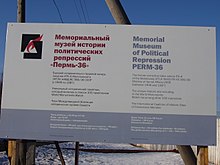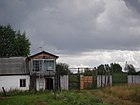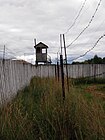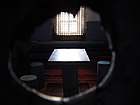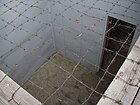Perm-36 Gulag Museum
The memorial of the history of political repression "Perm-36" (russ .: Мемориальный музей истории политических репрессий "Пермь-36";. Transkr Memorialny musej istorii polititscheskich repressi "Perm-36" ) is the only gulag - Museum on the entire territory of Russia which is located on the site of a former labor camp . The museum was founded and managed by the Russian non-governmental organization Perm-36.
After disputes with the authorities, the museum had to be closed in spring 2014. In the summer of 2014, it reopened under new management appointed by the local authorities and its exhibition was redesigned in the months that followed.
camp
History of the camp - from ITK-6 to Perm-36
The Perm-36 camp existed for more than 40 years. 1943 was in the village in the district of the city Kutschino chusovoy , in the Perm region in the Ural founded since 1946, it is located at its current location. From 1946 to 1972 it was called ITK-6 (Labor Reformatory No.6 - исправительно-трудовая колония №6). ITK-6 was a typical camp of its time. While the Gulag system in the 1930s consisted of large, widely spaced camps, in the late 1940s there was a move towards setting up camp networks with small camps (around a thousand prisoners) that were not far apart. These camps were cheaper to build and mostly had a short lifespan: after the work tasks had been completed (building a canal, logging work), the prisoners moved on and the camps were either destroyed or left to decay.
ITK-6 was established as a warehouse for logging work. Due to its favorable location for timber removal, directly on the Chusovaya River , the warehouse was not abandoned after the surrounding forest areas had been cleared, but upgraded and engineered so that more distant forest areas could be reached with trucks and tractors. In addition, storage rooms and various workshops, such as a forge and a sawmill, were built on the camp site. ITK-6 was the first mechanized warehouse in the region and one of the first in the country. In 1952, one of the four residential barracks was converted into a kitchen building with a dining room.
After Stalin's death in 1953, ITK-6, unlike many other camps, was not closed due to its good infrastructure and equipment. From 1954 on, high-ranking members of various state organs (police, secret service, courts) sat in ITK-6, who had once sent people to the Soviet labor camps themselves. These special prisoners were given a number of special rights, such as better food, but the camp's cultural program was also expanded for them, so they even got to see foreign films. However, the prosecution and condemnation of the crimes of the Stalinist perpetrators did not last long, and soon only ordinary members of these bodies were held in ITK-6 for ordinary crimes.
During this time, the security measures in ITK-6 were significantly tightened, because the new inmates knew the usual security systems. In addition to reinforcing the fences, new alarm and signal systems were installed.
From 1954 to 1972, ITK-6 served as the only "special purpose" camp in the USSR. In the course of the new repression and isolation policy of the Soviet government against political dissidents at the beginning of the 1970s, ITK-6 with its high security standards became a camp for political prisoners . To this end, the safety precautions were tightened again: the old furnace heating system, which until then allowed the transmission of secret messages, was replaced by a central heating system. The fences and alarm systems have also been tightened again. In 1972 ITK-6 received a new coding in accordance with the tightened confidentiality policy: VS-389/36. Human rights activists derived the name "Perm-36 - camp for political prisoners" from this.
In addition to the "strict regime" in Perm-36 (in the USSR four security levels were distinguished: "simple", "reinforced", "strict" and "special regime") the sector of the "special regime" of Perm-36 in In operation, which was a few hundred meters from the main camp. From 1980 to 1987 the “particularly dangerous repeat offenders” of the “particularly dangerous state criminals” were locked up in their cells 24 hours a day. These prisoners had served sentences for “crimes against the Soviet state” (Article 70 of the Criminal Code of the USSR: “anti-Soviet agitation and propaganda”) and were then convicted again for similar “crimes”. The prisoners were u. a. about activists of national independence movements ( Ukraine , Baltic States ), about human rights activists and members of the so-called "Moscow Helsinki Group". The "special regime" of Perm-36 was the first and only camp in the entire Soviet Union that was exclusively intended for political prisoners. This part of the camp was much smaller than the part of the “strict regime”: at the same time, between 35 and 40 prisoners were held here. In its seven years of existence, 56 prisoners were subjected to the "special regime". According to official information, seven people died there during these seven years, the most famous of them: the Ukrainian poet Wassyl Stus , who was proposed for the Nobel Prize for Literature at Heinrich Böll's suggestion , and three other members of the Ukrainian “Helsinki Group”: Jurij Litvin, Valerij Marčenko and Aleksa Tichij.
When the camp closed in 1987, most of these political prisoners were released and later rehabilitated. Some were transferred to the Perm-35 labor camp, which still exists today. After the closure, part of the "strict regime" of the camp was handed over to the health department, which used the building for the home for the mentally ill, which is also located in the village. In the course of this reorganization, the security systems were removed and many of the buildings were rebuilt or destroyed.
After a Ukrainian television team filmed a report on the "special regime" of Perm-36 in 1989, the Permian Penal Service dismantled the security systems that were still there.
In 2009 and 2010, the Perm Opera House put on musical theater in the remnants of the camp. In 2009 it was a commissioned composition based on Solzhenitsyn's A Day in the Life of Ivan Denisovich . In 2010, the score of Beethoven's Fidelio became the basis for a “convertible concert” for 250 spectators each.
- Camp Perm-36 and its surroundings
Everyday life in the warehouse
Working in Perm-36
- 1946–1953 logging work in the forest (labor norm per prisoner: 3.5–4 m³ wood per day)
- 1953–1972 Woodworking work on the camp grounds
- 1972–1987 Manufacture of small parts for irons
Daily routine of a political prisoner around 1972 under a strict regime
- 6 a.m .: Wake up the prisoners
- 6 am - 7 am: time to wash and for breakfast (porridge and some bread)
- 7 a.m .: Start of work in the work zone - at the transition from the living area to the work area, the inmates at the checkpoint were thoroughly searched
- 12pm - 1pm: lunch break (soup and porridge), on the transition from the work to the living area and on the way back to work, the inmates are searched again
- thereafter the working day continued until 6 p.m., the inmates were searched again at the checkpoint
- 6–8 pm: Dinner (soup or porridge) and free time that was spent doing sports (there was a volleyball court), visiting the library, drinking tea.
- 8–10 p.m .: political seminars and lectures for the purpose of re-education of the prisoners, which, however, could be attended voluntarily and were therefore not very popular
- 10 p.m - 10.30 p.m .: check of prisoners in the evening
- from 11 p.m .: rest at night
Famous inmates
- Leonid Borodin (* 1938), Russian writer
- Balys Gajauskas (1926–2017), Lithuanian, spent 38 years in Soviet camps. The first time he was arrested for connections with Lithuanian partisans in 1948 and sentenced to death. The death penalty was later commuted to 25 years in prison. He learned eight foreign languages while in captivity. In 1973 he was released, only to be arrested again in 1978 and sentenced to 10 years imprisonment under the special regime. His crime: he had translated Alexander Solzhenitsyn's book The Gulag Archipelago into Lithuanian and collected documents on the history of Lithuanian resistance movements. After his release in 1987, Gajauskas worked briefly in 1992 as general director of the Lithuanian secret service VSD and was a member of the Lithuanian parliament.
- Sergei Kowaljow (* 1930), later Human Rights Commissioner of the Russian Federation
- Levko Lukjanenko (1928–2018), politician, diplomat and writer
- Wassyl Stus (1938–1985), Ukrainian poet and literary critic
- Michail Meilach (* 1944), literary scholar
- Nikolai Braun (* 1938), poet, translator, publicist
- Natan Sharansky (* 1948), dissident, later Israeli politician
- Gleb Jakunin (1934–2014), Russian Orthodox priest
- Juri Orlow (* 1924), physicist, dissident
museum
History of the museum
In 1995 the Russian non-governmental organization "Perm-36" opened the Memorial to the History of Political Repression "Perm-36" on the premises of the "Special Regime" department of the former labor camp. The museum is the only surviving Gulag labor camp on the entire territory of Russia. Since then, the camp has been gradually rebuilt, with large parts being rebuilt by Russian and international volunteers in summer camps. Since 2007 the camp part of the "Strict Regime" has been open to visitors.
One of the four (or later three) former prisoner barracks, in which up to 250 prisoners could be housed, can be seen in the living area of the former camp site of the "Strict Regime". Several exhibitions are currently housed in it. The staff building, built in 1972 on the site of a prisoner barracks, has also been preserved; there is (as from 1972 to 1987) a small library and a cinema, kitchen and canteen, as well as the rooms of the museum administration and offices for museum employees. This part of the camp also houses the hospital and medical barracks, a toilet block with 14 “places” for up to 1000 prisoners (a number that was not reached) and the schtrafnoj isoljator , the isolation cell block . Many of these buildings date from 1946 to 1952 and thus from the Stalinist Soviet Union.
In the work area of the camp, which you get through the rebuilt control station, which the prisoners also had to pass through and which were subjected to a strict body search every time, there are workshops of the camp: a forge, a sawmill, and also a boiler house, which was the function of this to heat the warehouse, the nearby houses and the barracks of the prison guards, and a turbine house to ensure the internal electricity production of the camp. The administration building, in which the guards were also housed, is also located in this part.
aims
The aim of the museum - until the intervention of the regional government in 2014 - was to preserve the former camp as a witness of the times, to locate, compile and preserve historical documents about the political repression in the USSR. This was intended to remind of the violence and terror of the Soviet system and to contribute to historical and political education in Russia. With this in mind, the aim was to organize exhibitions on relevant topics and to promote civil society engagement in Russia.
Influence of the authorities
The museum, which is supported by civil society, was co-financed by the regional government until the end of 2013. According to this, the financing should be regulated through a cooperation agreement between the sponsoring association and a body created by the regional government. However, since the regional government delayed its signing on the one hand and no more subsidies were paid on the other hand, the association was no longer able to pay electricity and water bills. As a result, in April 2014, the memorial was denied further energy supply and had to be closed. In May 2014 the director Tatjana Kursina was dismissed for alleged "mismanagement" on the part of the regional government and replaced by an employee of the local Ministry of Culture. Operations were temporarily suspended and the “Pilorama” citizens' festival that had been taking place in the museum for many years - as in 2013 - was canceled. A documentation of the museum by the Kremlin broadcaster NTV denounced those responsible as the fifth column of enemies of Russia. Prison veterans and members of the local Communist Party branch and the neo-Stalinist organization "Essence of Time" took offense when the museum also recognized members of the Ukrainian and Baltic independence movements as innocent prisoners of conscience.
On July 16, 2014, Russian media reported that the former camp gate was destroyed during clean-up work in the museum.
Dissolution of the museum association in 2015
In a telephone conversation with the British BBC in early March 2015, former director of the museum Viktor Shmyrov complained that the local authorities in Perm had gradually brought the museum under their control since 2013 on the grounds that water and electricity bills had not been paid have systematically changed its content in the past few months. According to him, the memory of Stalin and the repression during the Stalin era will be erased. Now it is a museum about the camp system and not about political prisoners. Shmyrnow expressed the view that the reason for this lies in the current political realities of Russia. In Russia, under President Putin, a system with an enormous concentration of power in the hands of a single person had developed again, similar to that in the Stalin era. The country is moving back towards totalitarianism. There is no repression comparable to that of the Stalin era - this is not necessary either, since the people have become docile.
In view of the impending dissolution of the former sponsoring association, the FAZ reported that its activists want to continue their research on the tragic history of their country in a low profile, purely academic framework.
In the same month, in March 2015, the fear was confirmed that the association would have to dissolve after months of negotiations with the regional government with the aim of setting up the museum in a public-private partnership as a museum of political repression in the various phases of the government To operate the USSR had failed. The association was dissolved in August 2016 after payment of all penalties that arose in connection with the entry in the agent register.
Reopening and realignment in the interests of the authorities
In the summer of 2014 the museum reopened under the sole sponsorship of the regional authorities. In the following months, the focus of the exhibition was shifted, which since June 2015 has focused on the prisoners' contribution to building socialism instead of commemorating the victims of the repression. You would have - so the new representation - z. B. contributed to victory in the Great Patriotic War through their wood deliveries for shelters and trenches . During tours of the museum it is now emphasized that the prisoners were "enemies of the Soviet Union" and "criminals". The new museum curator, Jelena Mamajewa, stated that it was not "politically correct" to judge Stalin.
As a result of the protests across Russia and the intervention of the Russian Human Rights Council, however, the concept of the museum was gradually brought closer to the original concept from 2016, with the exhibitions once again focusing on the victims of repression.
literature
- Immo Rebitschek: New measurement and redesign of a place of remembrance: The Perm'-36 memorial . In: Jörg Ganzenmüller , Raphael Utz: Soviet crimes and Russian memory. Places - Actors - Interpretations ( Europe's East in the 20th Century. Writings of the Imre-Kertész-Kolleg Jena , 4), de Gruyter Oldenbourg, Munich 2014, pp. 91–108.
- Anke Giesen: Perm-36 , In: Dekoder from September 5, 2018
- Anke Giesen: “How can the victor be a criminal?” A discourse-analytical study of the Russian-wide debate about the concept and nationalization process of the “Perm'-36” camp memorial in the Urals, ibidem-Verlag, Stuttgart 2019.
Web links
- Website of the former museum sponsor (Russian, English, German) . The website has been deleted, the domain perm36.ru is for sale (as of November 7, 2017).
- Christian Weisflog: Russia nationalizes the Gulag Museum. The hour of the Stalinists. In: Neue Zürcher Zeitung from August 8, 2014.
- Current website of the museum
Individual evidence
- ↑ a b c d e Kerstin Holm : In the winner camp . In: Frankfurter Allgemeine Zeitung of July 29, 2015, p. 9.
- ↑ FAZ of July 10, 2010, p. 33.
- ↑ Online petition initiated by Memorial to the Governor of the Perm Region Online (Russian)
- ↑ German-language petition Only when 51,000 had already participated in this petition did the petition appear in other languages from July 4, 2014.
- ↑ Radio Free Europa report on July 6, 2014
- ↑ NTV broadcast on youtube ( Memento from October 17, 2014 in the Internet Archive )
- ↑ u. a. Workers have started to destroy the Perm-36 Museum (Russian) Komsomolskaya Pravda on July 16, 2014; A detailed history of the state intervention , in: Novaya Gazeta from July 7, 2014; s. a. Ann-Dorit Boy: The enemies of the state rightly languished , in: FAZ on July 19, 2014, p. 19 and Sven Felix Kellerhoff : How Putin ruins the memory of the Gulag , in: DIE WELT on July 22, 2014 [1] . The federal foundation for the coming to terms with the SED dictatorship protested on August 4, 2014 against the redesign of the memorial [2]
- ↑ Laurence Peter: Stalin wiped from the Soviet Gulag prison museum. BBC News, March 3, 2015, accessed March 3, 2015 .
- ^ Perm-36. Off for the only GALag museum . In: Frankfurter Allgemeine Zeitung of March 5, 2015, p. 9.
- ↑ The only Gulag memorial in Russia closes its doors , accessed on August 15, 2015.
- ↑ Шаповалов Андрей: Интервью / Политические репрессии. Чтобы помнили / Андрей Шаповалов. Retrieved January 2, 2020 (Russian).
Coordinates: 58 ° 15 ′ 48 ″ N , 57 ° 25 ′ 49 ″ E
